New Ways to Boost Packaging Line Uptime
Packagers are boosting operational efficiency with advanced tools and techniques, including predictive maintenance, 3D printing of parts, and Machinery as a Service.
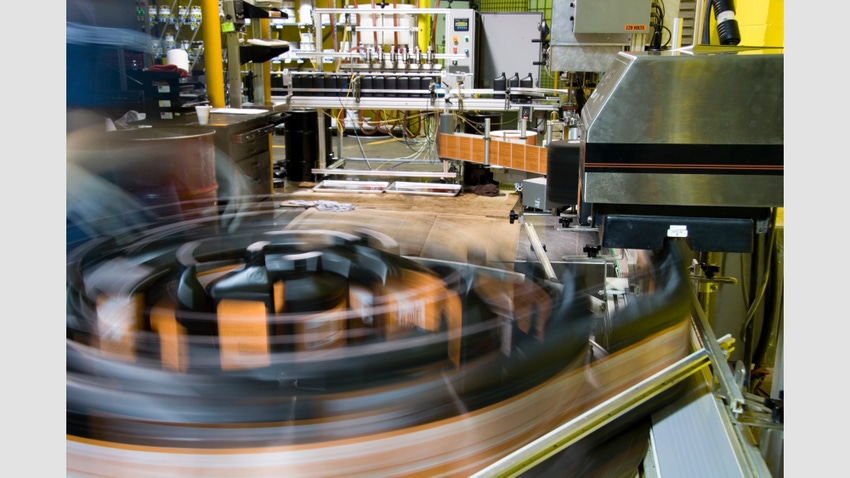
Packaging automation continues to evolve in tandem with digital technology, driving greater productivity and acceptance among plant operations managers, packaging engineers, and consumer packaged goods (CPG) executives.
Several technologies continue to enable the digitization of packaging operations, including Industry 4.0 and the Internet of Things (IoT), cloud computing, and 3D printing. The Machinery as a Service (MaaS) business model is playing a supportive role for some packagers, as well.
Through these technological breakthroughs, packagers are enjoying myriad benefits, including reduced downtime, lower maintenance costs, longer equipment life, less need for replacement parts, greater plant productivity, and optimized return on investment (ROI) for the machinery.
Predictive vs. preventive maintenance.
Predictive maintenance is often conflated with preventive maintenance, but they are definitely not the same thing. The main difference is that predictive maintenance aims to get out ahead of packaging line problems, identifying when a failure is imminent and preventing it, thus avoiding downtime.
“Preventive maintenance is done on a periodic basis,” says John Henry, the changeover wizard at Changeover.com. The schedule could be on calendar time, as in every 30 days; on clock time, as in how long equipment was running, measured by an internal clock; by production volume or machine cycles; or by some other fixed frequency.
In contrast, “predictive maintenance looks at machine operation and predicts when it will need maintenance,” Henry says.
In a predictive maintenance program, various machinery characteristics are measured, often using smart sensors that monitor equipment and communicate its status to plant managers and engineers.
Common metrics include run time, speed, and a motor’s current/voltage draw, as well as vibration, humidity, pressure levels, gas levels, and temperature. Analysis of the collected data then pinpoints what needs to be repaired to avoid shutting down the packaging line.
For example, say “the normal temperature of a motor is 100 degrees. A continuous temperature monitor is installed, connected to a system, and as long as it stays in a range of 95 to 105, [maintenance] does nothing,” Henry says. “If it starts climbing to 106 on Monday, 107 on Tuesday, and so on, a work order is generated to investigate why, before it gets to 130 degrees and burns out.”
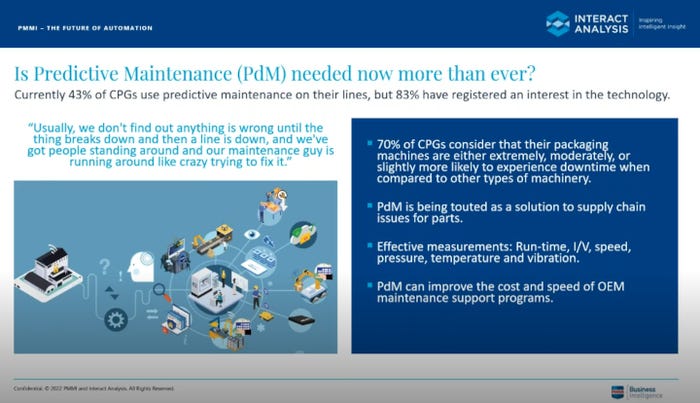
Interact Analysis and PMMI
Predictive maintenance and the future of automation.
Research from the Packaging Machinery Manufacturers Institute (PMMI) shows keen interest in predictive maintenance among CPGs. PMMI worked with research group Interact Analysis to survey CPG executives and engineers in the United States about the future of automation in packaging and processing.
In a webinar discussing the research results, Interact Analysis CEO Adrian Lloyd said that less than half of the survey’s 119 respondents “currently use predictive maintenance on their lines, but a very large proportion of them have indicated an interest in this technology.”

Lloyd added, “Predictive maintenance is a fairly immature technology, so even though 43% of CPGs are using it, it’s probably being prototyped in one or two areas of their plant but is not widespread. So there still remains a very large opportunity for this type of technology to be deployed.”
Drivers for adoption include falling costs for predictive maintenance and CPGs’ greater willingness to give equipment vendors and service suppliers remote access to their plant’s packaging equipment.
“Sensors for temperature, oil quality, oil pressure, current draw, vibration, and more have become much better, as well as much cheaper,” Henry says. “Now a vibration sensor is cheap enough to put everywhere. Data [is] sent continuously to a computer and accepted with no action, if within limits.”
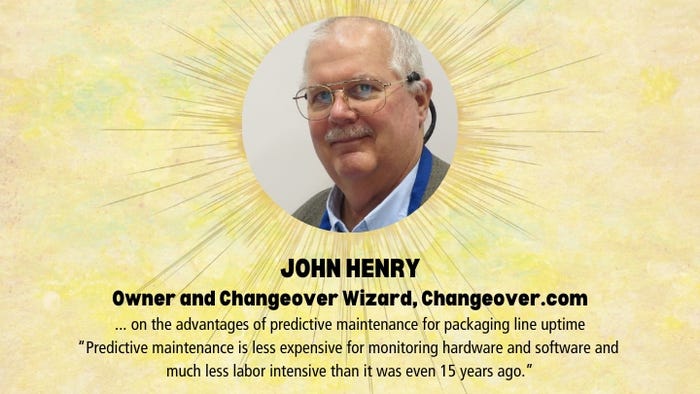
If a level strays outside prescribed limits, the sensor triggers an alarm. “It can send an email, sound an alarm, generate a work order, or otherwise cause action to be taken,” Henry explains. “So predictive maintenance is less expensive for monitoring hardware and software and much less labor intensive than it was even 15 years ago.”
Additionally, CPGs have become more comfortable with vendors remotely accessing their machinery, thanks largely to changes in operations and maintenance that started during the pandemic. “CPGs are [now] a lot more comfortable with the idea of providing remote access to their plants,” Lloyd notes.
Remote access “opened up during the pandemic, and CPGs have come to realize it’s both doable, and there are benefits associated with it,” he adds. Remote access “represents an opportunity for packaging machinery companies to provide advanced maintenance services using predictive maintenance as a mechanism for doing that.”
Packagers 3D-print their own spare parts.
As a complement to predictive maintenance, packaging plants are starting to use 3D printing, a type of additive manufacturing, to create their own spare parts on-site. In this scenario, a close relationship between equipment vendor and customer is again essential.
“The use of 3D printers to produce spare parts for automated equipment has rapidly become a reality, and use of this new but fast developing technology is particularly attractive because it has a positive impact on the ROI for machinery as parts can be produced more cheaply,” PMMI’s Future of Automation report reveals. “Perhaps more importantly, it circumvents supply chain disruptions and cuts lead times.”
Although 3D-printed parts don’t have “a specific place or subcategory in a predictive maintenance program … [the technology] allows the opportunity to easily design and manufacture features like wear indicators to help monitor the condition of a part,” says Patrick Reeves, engineer, innovation and R&D, at Zepf Solutions, an aftermarket part supplier and division of Barry-Wehmiller.
3D printing also eliminates the extra setup and process time needed for traditional subtractive manufacturing of parts. “By not adding extra cost … 3D-printed parts can have a big impact on predictive maintenance programs,” Reeves says.
Packagers that are printing their own parts “have invested in scanners and 3D printers, realizing that instead of stocking spare parts on the shelf or waiting weeks for parts to be manufactured and shipped to them, they can scan a new part, print one to test its functionality, and then keep a digital inventory of the part files to be printed on demand,” Reeves explains.
The trend is a distinctly different direction for OEMs. Under their traditional business model, parts drawings and designs were closely guarded; this intellectual property was not shared with customers, for fear of crippling the OEM’s spare parts business.
But “OEMs are not going to be able to stop this,” Reeves says. “As technology advances and new materials are developed, end users are going to have the ability to scan and print parts on their own.”
Moving forward, equipment vendors will need secure methods for making digital files available to customers for 3D printing, as well as ways to ensure that customers are charged for every use of the files, to maintain the OEM’s spare parts revenue stream.
Reeves observes that there are currently packaging equipment manufacturers that enable their customers to 3D-print spare parts “and go as far as providing the 3D printer with the new machine when it is sold to the customer.”
Krones supports 3D printing on demand.
A pioneering OEM in the 3D-printing space is Krones, which offers its customers an array of products and services to print their own spare parts. That includes printers, KIC Krones 3D-printing filaments, training, and consulting. The Krones program is called Rapid Parts on Demand (RPOD).
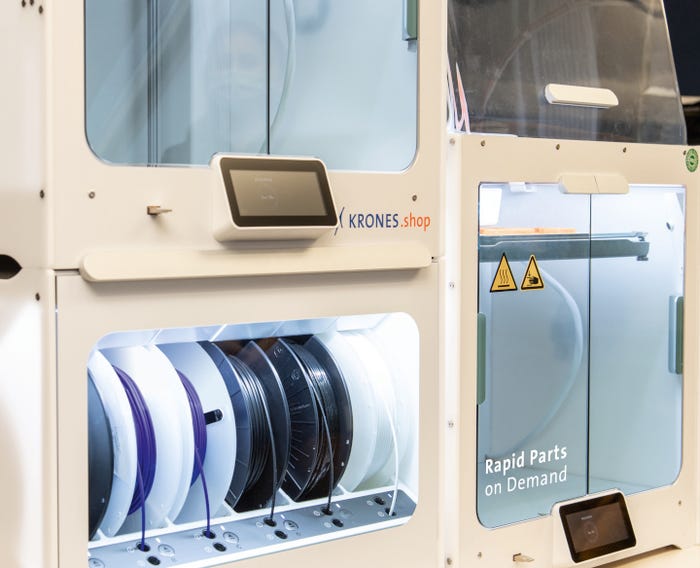
Krones
Using digital services from Krones.shop, the RPOD customer “can start any printing process, has an overview of the printer status, and also has the analytics category for filaments needed, spare parts printed, and so on,” says Krones AG spokesperson Peter Moertl.
The customer can use its own Ultimaker S5 or S7 3D printer, if it has one; if not, Krones provides the printer. The company charges a fee for consulting and training and has a license model for 3D-printed parts.
“The 3D-printed part can serve as an ‘emergency part’ until the original part arrives. But it is also possible [to print] a 3D part that matches the life and characteristics of the original,” Moertl says.
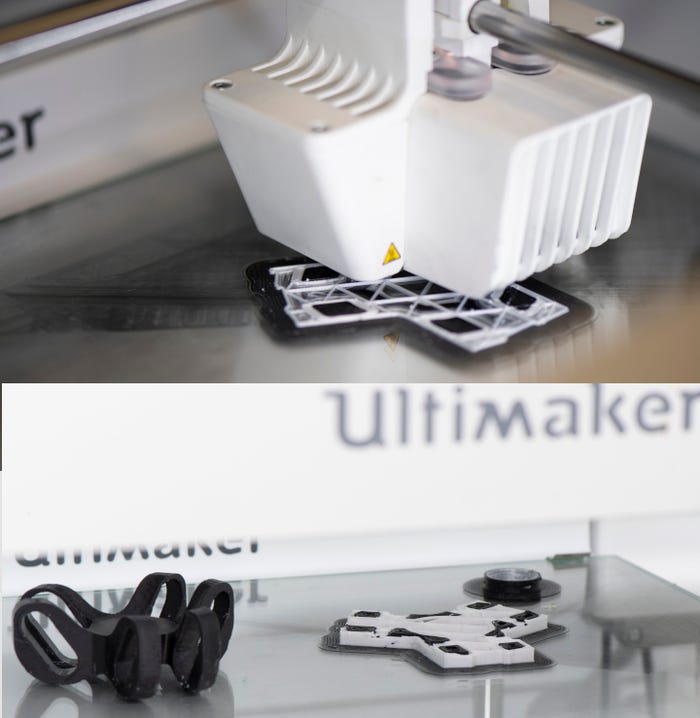
Krones
Demand for self-printed spare parts “is increasing and so are the possibilities of the various applications, so packers are aware of this possibility,” Moertl adds. “A number of customers are already using the service. It is striking that the interest is growing worldwide and not only in certain regions.”
Early days for MaaS in the packaging industry.
The final part of our packaging automation conversation concerns MaaS, a service/support model that’s common for some non-packaging equipment, such as photocopiers.
MaaS is not yet commonplace for packaging equipment, but a few machinery suppliers, notably robotics companies, are pioneering this business model. Formic Technologies, for example, uses what it calls a “pay for productivity” model for its robotics equipment.
With this model, Formic designs and installs a robotic solution, and when the system starts operating, the customer is billed on the basis of system use. Formic says this approach can reduce the customer’s cost by up to 40%, vs. manual labor.
Formic provides round-the-clock remote monitoring, lifetime maintenance of the robotic equipment, and a dedicated support team to optimize uptime. When the contract expires, customers can renew, upgrade, or return the equipment to Formic.
With MaaS, Lloyd explains, the onus is on the machinery manufacturer to keep the equipment running, and contracts are often predicated on uptime.
Therefore, the equipment maker will provide “constant repair service instead of trying to sell you the next greatest product immediately after the moment they’ve just sold you one. They’ve suddenly got skin in the game,” he says.
The underlying driver for predictive maintenance, similarly, is “maintaining the operation … keeping the machinery running. That’s the thing upon which CPGs are going to measure the success of the machine,” Lloyd says.
“Can you implement a predictive maintenance strategy that is going to keep that piece of equipment running?” he asks. “If you can do that, and especially as a machine builder, if you’re able to track that machine remotely and send in staff as needed to keep that thing running, the value proposition that brings to the CPG, I suspect, is off the charts.”
About the Author(s)
You May Also Like




